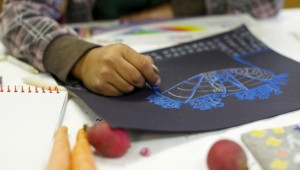The Incredible Children’s Art Network Picks Up Speed
By Leslie Dinaberg
in-cred-i-ble: [in-kred-uh-buhl] adjective
1. so extraordinary as to seem impossible: incredible speed.
2. not credible; hard to believe; unbelievable: The plot of the book is incredible.
Flying mostly under the radar until recently, the art-minded philanthropy of the Incredible Children’s Art Network (iCAN) has been quietly lending support to a handful of local elementary schools since 2005. Now, with a large new facility in the works at 222 E. Canon Perdido St. and an even bigger vision for the future under the direction of new executive director Jeffry Walker, iCAN is set to soar even higher.
Collaboration is a big part of that vision for Walker, a recent transplant from Carmel, whose youthful excitement about iCAN belies his more than 35 years of community arts education leadership.
Looking to the future of iCAN—which currently has visual art programs in place at Adams, Cleveland, Franklin, Harding University Partnership, McKinley and Monroe elementary schools, as well as an afterschool program at Franklin providing free music instruction to 90 students, five days a week—Walker says, “It’s not just around art and music as discrete disciplines, but really around youth development issues and community building issues. We have a pretty wide view on who we think we would work with or be aware of what they’re doing… At this point, it’s fair to say that most of our preliminary conversations are focused on creating a through-line for kids in elementary school and beyond.”
Jackson Sierra, whose son Dakotah is a third grader at Franklin (with both the art and music program, which is inspired by Venezuela’s renowned el Sistema model) says, “The program as a whole is awesome… My son has benefited from his music education by being able to read sheet music and write his own music, as well as his love for musical instruments.” In addition, “It has helped him with his math, also with his timing, and helped with his team player skills.”
Indeed, there is overwhelming evidence that involvement in the arts is associated with gains in math, reading, cognitive ability, critical thinking and verbal skills, as well as improvements in motivation, concentration, confidence and teamwork. Unfortunately, nearly a decade of painful budget cuts have decimated funding for these programs in public schools, leaving parents frantically fundraising to fill in the gaps. Not all schools have a population that can do this, which is one of the reasons iCAN was founded: to bring high-quality arts programs to children in Santa Barbara County, particularly to those least likely to receive them.
iCAN also seeks to affect positive social change in the communities it serves, which seems to be working.
“iCAN has really made our school into a more confident and creative place,” says Shannon McCain Jaffe, iCAN art teacher at Franklin. “iCAN has really contributed to change the climate at our school with the art and music…giving the students these kinds of materials and saying, ‘You’re worth this, and you deserve this, and now see where you can take this, where you can go.’ I think iCAN really just planted that seed that they are important, that this is a valuable thing, art, and gave them that opportunity.”
“Plus, it’s wonderful to see the kids delighting in what they know today that they didn’t know yesterday,” says Walker.
“We’ve been lucky enough that all of our principals…have made a point to show their support constantly in any way they can to our program, and that’s not something you necessarily get with nonprofits working with schools. We’ve been really, really lucky,” says Hillary McCall, iCAN communications and development manager.
“So many times…in the arts, we struggle in an environment of scarcity all of the time, not only financial resources but in terms of level of air space that is even given in the community dialogues…So to come into a community where arts education is already on that radar and already worthy of the conversations is pretty brilliant,” says Walker.
“Our project for the next few years will be to realize those aspirations.”
For more information about iCAN, call 805/845-5142 or visit icansbc.org.
Originally published in the Fall 2013 issue of Santa Barbara SEASONS Magazine.


